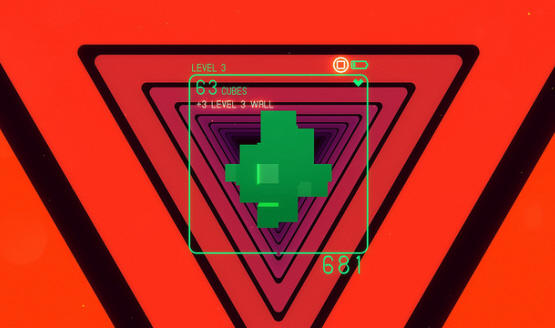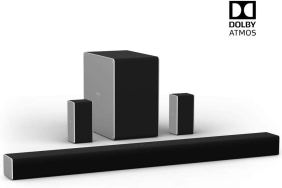Spatial reasoning and awareness. That’s what SuperHyperCube is all about. How do you fit a specific shaped block into a certain shape of slot? If it sounds like something you are familiar with, that might be because one of gaming’s oldest franchises hinges on this same train of though. SuperHyperCube is clearly inspired by Tetris, from the pumping retro design, to the core gameplay being all about fitting blocks into tight spaces. The difference this time around? It’s all in virtual reality. It’s immersive. You don’t sit down in front of a screen. You sit down inside the game and fit cubes through holes in walls using simple rotational controls on the DualShock 4. That’s all there is to it.
SuperHyperCube is extremely simple. An ever growing cube — or mass of cubes, rather — moves forward at a constant pace, sitting directly between your line of vision and a hole in a wall on the far side of it. Your task is to rotate the cube amalgamation until it can fit through the hole, each success adding more cubes for an increasingly complex shape. In addition to the complexity of the cube, you must lean around the mass in order to try to see what shape the hole on the far wall requires. Fail to match up to the hole and the wall breaks some blocks off, lowering your potential score. Miss a second time and your run ends, sending you back to square one, or cube one, rather.
There’s not much more to say about SuperHyperCube. There aren’t any additional modes. There aren’t any kind of bonuses or level selects or anything. Starting the game presents a simple cube that grows until you lose, rinse and repeat. Along the way there are challenging walls that rotate as you approach them, and power-ups can be earned to help ease the transition into some of those harder and more complex shapes further along, each adding a bit of depth and strategy, but at the end of the day it’s just you, the cube, and the wall.
Addictive Boredom
I’d be bored of this game if it weren’t so addicting. Every loss I’m convinced that I’ll get luckier with the configurations next time, or that my spatial reasoning will improve. Sometimes I’ve got the shape right but it’s upside down. Sometimes I can’t make heads or tails of how to line the shape up. Other times I felt like a total pro, finding the perfect shape early on, slamming the square through the wall, only to confront another wall that bested me. Restart after restart, I kept watching that score counter in the corner grow. I watched friends’ high scores and I sought to beat them myself. SuperHyperCube tapped into that basal instinct in me, creating a hunger for competition through effectively simplistic gameplay.
A drive to keep playing for high scores does not necessarily a good game make, and while SuperHyperCube’s one mode is quite fun and addicting, it’s still just a single mode. Eventually I do hit that wall (again, pun intended. These are far too easy) where I don’t want to continue to ram cubes into walls. I scour the main menu for something else to do and find nothing except high score lists, finally opting to exit the game completely. SuperHyperCube isn’t a bad game by any means, but it lacks a certain kind of spark that could really make it something special. It remains simply what is, a game about getting cubes through holes in walls. Nothing more. Nothing less. Yet maybe it’s that very nature that makes it something special.
SuperHyperCube relies on simplicity in execution to become an accessible VR experience. It may not have a lot of deep content, but in the early days of consumer grade VR it’s a welcome addition to the lineup, showing exactly what the platform is capable of without taxing players too much. It’s not quite a must have game, but it perfectly encompasses the VR experience in a concise and accessible package. As much as I want to play it again and again, I also find no real desire to play it at all, a bizarre schism that perfectly echoes the disparity of the simple complexity present in SuperHyperCube.
SuperHyperCube review code provided by publisher. For more information on scoring please see our Review Policy.
-
Easy to pick up gameplay
-
That high-score itch
-
Simple yet effective use of VR
-
Lacking much content
-
Replayability relies on your desire for a higher score









